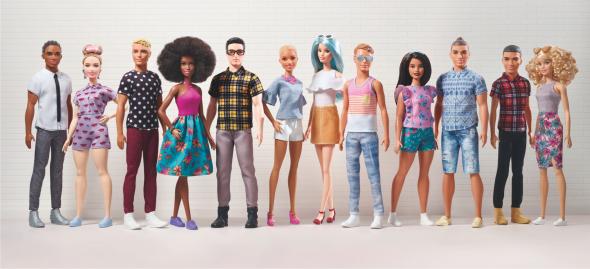Like everything from Dove body wash bottles to Oreo cookies—duh, they now let you choose from the classic version, Oreo Thins, or Double Stuf—to Barbie herself, Ken dolls will soon come in multiple shapes and sizes, to better reflect our patchwork quilt of a society, in which Goldilocks-ian consumers have become accustomed to options. As a hilarious piece by Caity Weaver in July’s GQ details, this means Ken, Barbie’s sometimes boyfriend and all-purpose male companion, will go from being one blond-haired, blue-eyed hunk to a deitylike being that inhabits many forms: man-bun Ken, mixed-race Ken, and shorter-but-not-in-a-way-that-makes-him-any-less-of-a-man Ken. The Ken makeover follows last year’s Barbie overhaul, which saw the introduction of curvy, petite, and tall Barbie doll shapes to the decades-old line of toys, along with additional skin color and hair options. So now it’s Ken’s turn, which meant Mattel had to ask itself: What would a “curvy” Ken look like?
Well, first of all, you could never call him that. The company eventually settled on producing dolls in “broad” and “slim” body types, in addition to the original model. But make no mistake, “broad” Ken isn’t heavyset any moreso than “curvy” Barbie is fat. He still has muscle definition; he’s just slightly taller, with slightly thicker limbs, than normal Ken, and he makes slim Ken look a little wimpy in comparison. Not that smaller stature has any real correlation to wimpiness.
One of the most fun parts of of the GQ piece is the window it provides into the different ways we talk about male and female body types, as filtered through the different ways we talk about male and female doll body types. As Mattel’s own consumer insights department would probably attest, people have strong opinions with regard to what these bodies should look like, and it is Mattel’s goal to land on types with which consumers have “a neutral-to-positive association.” It quickly becomes clear that, despite being praised for embracing inclusivity, Mattel is not interested in leading the charge on producing diverse toys. So applaud the new dolls, but don’t expect anything radical—actually fat Barbies, or transgender Kens—anytime soon. Mattel’s fundamental conservatism is evident not only in its long history of centering white, blue-eyed, blond, impossibly-shaped dolls but also in the company’s continued commitment to focus-grouping and market-testing its every move. Rather than set the tone, Mattel has followed dutifully behind consumer opinion. It’s a corporation, not a think tank, after all.
In any case, it’s fascinating to wade into the complicated cultural expectations of male body image, for a change. After many years of tortured discussion of “plus-size” female bodies, we’ve arrived at a near-universal solution in the form of curvy. Even though it’s a word that has now practically lost all meaning in this context, it’s still got a whiff of sexiness that strips it of negative connotations. In the GQ piece, a designer says that “[o]riginally, I made [Ken] paunchy. I gave him a nice healthy gut.” But he pulled back: “It was a matter of finding balance.” The designer knew instinctively that consumers would shun paunchy Ken.
The arrival of broad Ken hearkens back to another moment when the culture attempted to coin a term to describe male bodies that deviated from the standard ideal of beauty: the dadbod frenzy. A college student came up with the phrase dadbod in 2015 to reframe the love handles and soft bellies of comfortable middle age as more of a lifestyle choice than a marker of years. It quickly caught fire as slang—a descriptor not just for the bods of actual dads but for dad-shaped younger male bods, too—so much so that when the new Barbie shapes came out last year, on social media there were calls for “Dadbod Ken,” a version of Ken that was a little less ripped, a little more beer belly. But did dadbod catch on because it was a brilliant coinage or because we’re sorely lacking in words to talk about men’s bodies?
The journey to “broad” Kens shows us that whether we are dealing with dolls or real people, talking about men’s bodies isn’t that much less fraught than talking about women’s. The cultural conversation around the male form is also a mess of unrealistic expectations and heteronormative standards. For instance: Before settling on broad, Mattel tried plus-size, husky, athletic, and brawny, the executives bumbling around like they were trying to name a new line of paper towels.
Dadbod, at least, is whimsical; it’s a tongue-in-cheek attempt to bestow intentionality on imperfection, to make beery paunch seem less like the result of a bod gone to seed than like a fun trend that might be gamely embraced. You can feel the word dadbod straining to paint less-than-great physical shape as a virtue, a marker of approachable, everyman normalness, but as a euphemism it is likably self-aware. Broad, meanwhile, has all the charmless bulk of a Subaru. But it might not matter: The concept of “body positivity,” for all its contradictions, still doesn’t really apply to men, much less male dolls.
